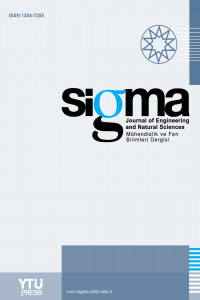Abstract
Using fuzzy aggregation operators, compensatory fuzzy approaches can be proposed for multi-objective problems. The variety of operators for the aggregation of objectives might be confusing and might make it difficult to decide which one to apply to the problem. For example while Zimmermann’s “min” operator provides numerical efficiency, it does not guarantee compensatory and Pareto-optimality. In this paper, we present brief information about some important compensatory fuzzy aggregation operators and then apply them to the Multi-objective Linear Transportation Problem (MOLTP) to obtain a compensatory compromise Pareto-optimal solution set. And an illustrative example is provided to compare these aggregation operators and to conclude which operator is more appropriate for the concerning problem.
Keywords
Transportation problem multi-objective programming fuzzy aggregation operators fuzzy mathematical programming
References
- [1] S.M. Lee, L.J. Moore, “Optimizing transportation problems with multiple objectives”, AIEE Transactional, 5, pp 333-338, 1973.
- [2] J.A. Diaz, “Solving multiobjective transportation problem”, Ekonomicko-Matematicky Obzor, 14, pp 267–274, 1978.
- [3] J.A. Diaz, “Finding a complete description of all efficient solutions to a multiobjective transportation problem”, Ekonomicko-Matematicky Obzor, 15, pp 62–73, 1979.
- [4] H. Isermann, “The enumeration of all efficient solution for a linear multiple-objective transportation problem”, Naval Research Logistics Quarterly, 26, pp 123–139, 1979.
- [5] J. Current, H. Min, “Multiobjective design of transportation networks: Taxonomy and annotation.” European Journal of Operations Research, 26, pp 187–201, 1986.
- [6] J. Current, M. Marish, “Multiobjective transportation network design and routing problems: Taxonomy andannotation”, European Journal of Operations Research, 65, pp 4–19, 1993.
- [7] J.N. Climaco, C.H. Antunes, M.J. Alves, “Interactive decision support for multiopbjective transportation problems”, European Journal of Operations Research, 65, pp 58–67, 1993.
- [8] J.L. Ringuest, D.B. Rinks, “Interactive solutions for the linear multiobjective transportation problem”, European Journal of Operations Research, 32, pp 96–106, 1987.
- [9] A.K. Bit, M.P. Biswal, S.S. Alam, “An additive fuzzy programming model for multiobjective transportation problem”, Fuzzy Sets and Systems, 57, pp 313–319, 1993.
- [10] S.K. Das, A. Goswami, S.S. Alam, “Multiobjective transportation problem with interval cost, source and destination parameters”, European Journal of Operations Research, 17, pp 100–112, 1999.
- [11] M. Ahlatcioglu, B. Karpak, M. Sivri, “Multiobjective Interval Transportation Problem”, Youngstone State University, Working Paper No.1, 1990.
- [12] L. Li, K.K. Lai, “A fuzzy approach to the multiobjective transportation problem”, Computers and Operations Research, 27, pp 43–57, 2000.
- [13] W.F. Abd El-Wahed, “A multi-objective transportation problem under fuzziness”, Fuzzy Sets and Systems, 117, pp 27–33, 2001.
- [14] Liu, S.T. and Kao, C., (2004) “Solving fuzzy transportation problems based on extension principle”, European Journal of Operational Research 153 (3): 661–674.
- [15] Chiang, J., (2005), “The Optimal Solution of the Transportation Problem with Fuzzy Demand and Fuzzy Product”, Journal of Information Science And Engineering, 21: 439-451.
- [16] Ammar, E.E. and Youness, E. A., (2005), “Study on multiobjective transportation problem with fuzzy numbers”, Applied Mathematics and Computation, 166 : 241-253.
- [17] Barough, A. H., (2011), “Fuzzy Cost Analysis in a Fuzzy Transportation System a Study of the Supply Chain Management in a General Contractor Company”, The Journal of Mathematics and Computer Science, 2(1): 186-196.
- [18] Ojha, A., Mondal, S.K., Maiti, M., (2011), “Transportation policies for single and multi- objective transportation problem using fuzzy logic”, Mathematical and Computer Modelling, 53: 1637-1646.
- [19] Anila Gupta, Amit Kumar, (2012), “A new method for solving linear multi-objective transportation problems with fuzzy parameters”, Applied Mathematical Modelling, 36(4):1421- 1430.
- [20] Anupam Ojha, Barun Das, Shyamal Kumar Mondal, Manoranjan Maiti, (2013), “A multi-item transportation problem with fuzzy tolerance”, Applied Soft Computing, 13(8): 3703- 3712.
- [21] H.-J. Zimmermann, “Fuzzy Set Theory and its Applications. Second, Revised Edition”, Kluwer Academic Publishers, Boston/Dordrecht/London, 1991, Sixth printing 1993.
- [22] Y.J. Lai, C.L. Hwang, Fuzzy Multiple Objective Decision Making: Methods and Applications, Springer, Berlin, Heidelberg, New York, 1996. (second corrected printing).
- [23] M.K. Luhandjula, “Compensatory operator in fuzzy linear programming with multiple objective”, Fuzzy Sets and Systems, 8, pp 245-252, 1982.
- [24] H.S. Shih, E.S. Lee, Compensatory fuzzy multiple level decision making, Fuzzy Sets and Systems, 114 (2000) 71–87.
- [25] H.-J. Zimmermann, “Fuzzy programming and linear programming with several objective functions”, Fuzzy Sets and Systems, 1, pp 45-55, 1978.
- [26] S. M. Guu, Y.K. Wu, “Weighted coefficients in two-phase approach for solving the multiple objective programming problems”, Fuzzy Sets and Systems, 85, pp 45-48, 1997.
- [27] E.S. Lee, R.J. Li, “Fuzzy multiple objective programming and compromise programming with Pareto optimum”, Fuzzy Sets and Systems, 53, pp 275-288, 1993.
- [28] Y.K. Wu, S.M. Guu, “A compromise model for solving fuzzy multiple objective problems”, Journal of the Chinese Institute of Industrial Engineers, 18,5 , pp 87-93, 2001.
- [29] H.J. Zimmermann, P. Zysno, “Latent connectives in human decision making”, Fuzzy Sets and Systems, 4 (1), pp 37-51, 1980.
- [30] H.K. Chen, H.W. Chou, “Solving multiobjective linear programming problems – a generic approach”, Fuzzy Sets and Systems, 82, pp 35-38, 1996.
- [31] S.M. Guu, Y.K. Wu, “Two-phase approach for solving the fuzzy linear programming problems”, Fuzzy Sets and Systems, 107, pp 191-195, 1999.
- [32] Tiryaki, F., “Interactive compensatory fuzzy programming for decentralized multi-level linear programming (DMLLP) problems”, Fuzzy Sets and Systems, 157, pp 3072-3090, 2006.
- [33] B.M. Werners, “Aggregation models in mathematical programming”, in (G. Mitra, Ed.), Mathematical Models for Decision Support, Springer, Berlin, 1988, pp 295-305.
- [34] Ahlatcioglu M., Tiryaki F., 2007, “Interactive fuzzy programming for decentralized two-level linear fractional programming (DTLLFP) problems”, Omega, 35: 432-450.
Details
| Primary Language | English |
|---|---|
| Subjects | Mathematical Sciences |
| Journal Section | Research Articles |
| Authors | |
| Publication Date | December 1, 2014 |
| Submission Date | September 23, 2013 |
| Published in Issue | Year 2014 Volume: 32 Issue: 4 |
IMPORTANT NOTE: JOURNAL SUBMISSION LINK https://eds.yildiz.edu.tr/sigma/


